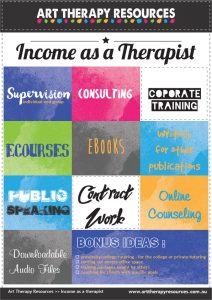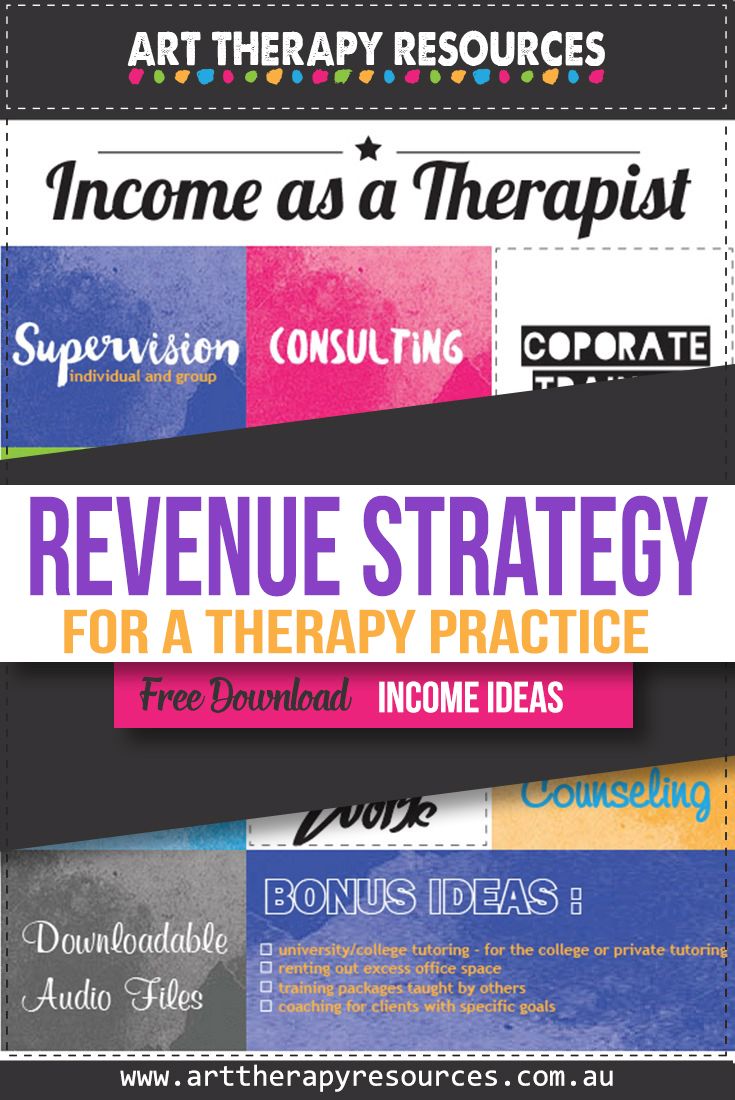THIS POST INCLUDES:
1. What is a revenue strategy
2. Why you need a revenue strategy
3. Components of a revenue strategy
4. Create your revenue strategy
5. Free Download Income as a Therapist
WHAT IS A REVENUE STRATEGY
A revenue strategy entails planning and executing purposeful actions. You can develop methods of earning an income, however, without a strategy, you could be undertaking these steps without any foresight on the best methods to use in your private practice based on your skills and your client demographic.
A revenue strategy helps you assess all relevant parts of your income and provides you with a way to maintain and increase each revenue stream.
Your strategy for revenue can include:
- Gaining new clients
- Keeping current clients
- Diversifying revenue streams
- Scaling revenue earning capacity
WHY YOU NEED A REVENUE STRATEGY
Any strategy will provide you with the primary benefit of focus. Therefore, a revenue strategy will help you become focused on the different types of revenue you can earn and how to improve each type to it’s potential.
For example, you can make a simple statement of “gain new clients” and to many, this might mean advertising, however, in developing a strategy for gaining new clients, you begin by analyzing all parts of your business that affects the process of ‘gaining new clients’.
If you are already advertising, you should not invest any more money into advertising until you assess whether your current advertising is working. This includes:
- How many clients make contact with your practice based on the advert
- Once the client makes contact, how does your office communicate with the client
- How does your office facilitate the booking process
- Does your office provide a variety of appointment times that would suit a wider range of clients
- Does your office provide flexible payment methods to pay for sessions
These questions are as important to the goal of ‘gaining new clients’ as simply spending more money on advertising. If you haven’t addressed the above questions, then spending more money on advertising might be a waste of resources and may not gain any new clients for your practice.
Earning revenue/income involves a combination of many factors including:
- Marketing – attracting clients
- Sales – converting potentials clients to paying clients
- Client experience – how your client interacts with your private practice
Balancing these three parts will result in earning the revenue you need for your business and to balance these parts, you need a strategy where all parts work together to achieve the same goals for your practice.
COMPONENTS OF A REVENUE STRATEGY
You can choose to develop revenue from a variety of streams or focus on one single revenue stream.
If you are a sole practitioner then your time is limited so you should focus on developing 1-2 different revenue categories. It is useful if you can develop at least two because having a second stream can be beneficial if your first revenue stream experiences a downturn for any reason.
Furthermore, if you become ill or unable to continue client work for a short period then your second stream may provide some additional revenue until you can resume client work.
The more people you have working in your business, the more you can diversify your revenue streams as the human resources can be divided amongst the various activities within your therapy practice. You may have therapists who focus solely on client work, while other therapists connect with community and corporate organisations to develop revenue on a larger scale.
You can also hire non-therapist employees who can produce and market physical products that suit your therapy practice.
Even if your practice isn’t large enough to hire staff, you can collaborate with other therapists or hire someone short term to achieve a specific task that will contribute to developing additional revenue streams.
GOALS
To develop your overall revenue strategy, it’s useful to start with knowing what your overall business goals are. Questions you can ask yourself to help develop your goals include:
- How many clients can you realistically work with each week?
- Do you wish to develop any ancillary products or services outside of client session work?
- What type of clients do you want to work with?
- Do you want to be a sole practitioner or work with others – could be hired staff or peers under a partnership
- If you are running a practice now, how effective do you think you are operating currently on the above goals?
PROFIT
- What levels of income do you need to earn to be a profitable business and pay yourself your desired wage?
- How many clients does this convert to each week?
- Will other ancillary products or services be developed to boost profit levels?
- Are there opportunities to reduce your operating costs in your business?
- Is your therapy practice competitive in price and service compared to other practices in your area?
- If you are running a practice now, how profitable is your private practice overall and on an individual product/service basis. For example, is group work more profitable than individual client work?
SALES PROCESS
- Do you have a sales funnel in place? Read more about sales funnels here: Create A Sales Funnel for an Art Therapist
- What is your sales funnel that you have in place and how can it be improved?
- If you don’t have a sales funnel in place, what would a sales funnel look like for your private practice?
- What parts of your sales process do you believe is currently the most effective?
- What parts of your sales process do you believe is currently the most ineffective?
ANALYSIS
- Do you have a system in place to regularly review how effective your marketing is?
- Do you have a system in place that helps you understand your financial position at any time?
CREATE YOUR REVENUE STRATEGY
When you develop your revenue strategy it’s important to remember that you should remain flexible and adaptable. If you develop a strategy and realise along the way that some of the tasks are difficult and causing more problems and stress in your life, then you should be flexible and either eliminate the problem or find an alternative way of reducing the impact.
Whatever strategy you develop for your therapy practice should stay in alignment with your ethics and personally held beliefs about how you choose to run your therapy practice. If something makes sense financially, yet doesn’t feel right for your business ethically, then you find an alternative strategy to achieve the same result.
Remember the strategy that you create is your best estimate of what you plan to do at this time. For some parts of the strategy, you may need to estimate amounts and percentages. This doesn’t mean you are forced to stick to these amounts. Instead, these amounts are provided as guidelines for you to work towards to achieve your overall income goals.
Below are the basic steps you should undertake to create your revenue strategy:
- Decide on your revenue streams – examples include client work, supervision, consulting, courses, books, workshops, writing, speaking, contracting etc. For more ideas, read: 10 Ways to Increase Your Therapist Income
- Allocate a percentage split to the different revenue streams, or dollar estimate if you want to – eg. 60% client work, 20% workshops, 10% books, 10% audio files for meditation
- For each revenue stream, create a list of your ideal client and where you might find your ideal client both offline and online – eg. Clients to be found through advertising online and GP (doctor) networks), workshops through women’s community groups and refugee community groups etc
- For each revenue stream, identify the resources that you need to accomplish each revenue stream. For example for client sessions, you need a booking process, payment method, professional network, external advertising etc. Resources may encompass people, software, equipment, supplies, advertising, images, money etc
- For each revenue stream identify the sales process of how you initially attract a potential client/customer, all the way through to making the final purchase or booking. If you like using visual cues, draw a line from one side of a page to the other and pinpoint along the way the various points at which you will:
- attract a potential client (eg. Social media, external advertising, referral)
- communicate with a potential client (eg. Email, phone calls, newsletter, social media)
- convert your potential client to a paying client (eg. Make an offer)
- retain your new client (eg. Staying in contact, prebooking appointments)
FURTHER READING
Below is a list of previous blog posts that will help you develop your knowledge of building your therapy practice:
BUSINESS BUILDING
MARKETING
- Create A Sales Funnel for an Art Therapist
- How to Build an Email List for your Therapy Practice
- How to Create a Free Offer to Build Your Email List
- Understand the Marketing Cycle of Your Art Therapy Practice
- What to do when you have no clients booked
- How to Plan Your Marketing Strategies
PROFITABILITY
- 10 Ways to Increase Your Therapist Income
- A One Page Business Plan for Your Therapy Practice
- Excel vs Accounting Software To Record Financial Information
- How to Create Physical Products for your Art Therapy Practice
- How to Record Income and Expenses for your Art Therapy Practice
- Strategies to Increase Profit For Your Therapy Practice
FREE DOWNLOAD: Income as a Therapist
SIGN UP below to download the FREE Income as a Therapist handout.

BUILD YOUR ART THERAPY REFERENCE MATERIALS:
Pin this image to your Pinterest board.

SHARE KNOWLEDGE & PASS IT ON:
If you’ve enjoyed this post, please share it on Facebook, Twitter, Pinterest. Thank you!
